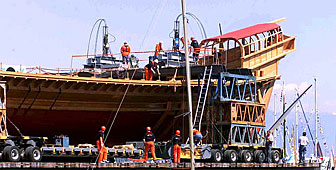Lake Geneva welcomes back oar-inspiring medieval galley

Lake Geneva has not seen its like for 400 years. An immense medieval galley in the port of Morges is recalling the days when these magnificent vessels waged war on these waters. It could also prove a renaissance for tourism.
With the arrival on the water of La Liberté, an important part of this region’s maritime heritage, which many believed had been lost forever, has been revived.
“Galleys actually existed here on the lake. They’re an important part of this region’s heritage,” says Jean-Pierre Hirt, the driving force behind the project.
“This is a fantastic opportunity, on an historical, educational and cultural level, to reconstitute that heritage,” he says.
The vital statistics of this majestic vessel make impressive reading. It weighs in at 190 tonnes and measures 55 metres in length. Its main mast will be 30 metres tall, and it will have 700 square metres of sail. One thousand cubic metres of local timber – Douglas fir, oak and larch – have been used.
Only beginning
Hirt says the operation to move La Liberté onto the water was just the end of the first stage. That first stage has been long, though. Hirt had the initial idea nine years ago. After two years of research and a year building the special wooden hangar in which the galley took shape, construction began in 1996.
La Liberté is still not complete. It is scheduled to set sail for the first time in June 2002, after its masts, lateen yards and interior fixtures have been fitted.
There were those that thought Hirt was foolish to embark on such a fanciful project. “Today I’m a happy fool,” he says.
Employed 600 jobless people
He admits that, back in the early 1990s, his prime motivation was not to build a galley, it was to give “confidence, hope, new skills and a better chance of work” to the local unemployed. “The galley was just a pretext,” he explains.
Over 600 jobless people have been employed in the project – either building the galley, in administration, reception or marketing – since work began.
“Liberté is the most beautiful word in the French language. But we also chose the word because of the freedom this project gave to those unemployed people,” Hirt says. “This is a collective work of art.”
La Liberté would have inspired awe and fear in the galleys that plied the waters hundreds of years ago. It is two times bigger than the Lake Geneva galleys.
Replica of Mediterranean galley
Because of a lack of documentation and tangible evidence, it was difficult to reconstruct a traditional Lake Geneva galley. La Liberté is, instead, a replica of a 17th century Mediterranean galley, built thanks to detailed plans and models lent by the Maritime Museum in Paris.
Yet the Lake Geneva galleys were direct descendants of these Mediterranean vessels. The Dukes of Savoy, who controlled much of the lake for centuries, brought craftsmen from the Italian city of Genoa to the region to build their boats, and they did so using their Mediterranean designs and techniques.
Unlike their descendants, the Barques, which ruled the lake in the 19th Century, the galleys main job was not the transportation of goods.
“The galleys were used mainly for war and for prestige – they allowed the House of Savoy to maintain its supremacy over this region.” Hirt says several naval battles took place on this strategically important stretch of water.
From the 13th century, that supremacy was challenged by the Bishopric of Geneva, and from the mid 16th century by Geneva’s allies from Bern. With the arrival of the Bernese forces, another kind of galley appeared on the lake. These vessels, which were built in Geneva, resembled those that sailed on Lake Constance.
La Liberté has caught the imagination of local people. Some 45,000 people turned up to see the galley moved from its wooden hangar onto the water. Their enthusiasm is not surprising given what the project has done for local unemployed people and promises to do for the local economy.
Such has been the interest in the project that, since the building of La Liberté began five years ago, 150,000 members of the public have visited the construction site.
Plans for medieval village
Jean-Pierre Hirt’s long-term plan is to create a suitable home for the galley – a medieval port village. This living museum of ancient crafts, it is hoped, will become a major tourist attraction in the region. And undeniably, an interactive Middle Age community will be an invaluable educational resource too.
“You can learn more from real men and women, engaged in real activities, than from history books,” Hirt believes. To create this theme village and to operate the galley, the association responsible for building the boat will become a limited company.
It reckons the galley will make over 600 two-hour trips every year, carrying around 50,000 passengers. As well as pleasure trips around the lake, La Liberté will also be available for private parties.
The galley will principally rely on wind power and two engines. But about four times a year, on special occasions, a team of 123 volunteer rowers will take up the 41 oars. Already no fewer than 3,000 people – young and old, men and women – have offered to be trained as galley oarsmen, a sign perhaps of how much this project means to the local community.
by Roy Probert

In compliance with the JTI standards
More: SWI swissinfo.ch certified by the Journalism Trust Initiative
You can find an overview of ongoing debates with our journalists here . Please join us!
If you want to start a conversation about a topic raised in this article or want to report factual errors, email us at english@swissinfo.ch.